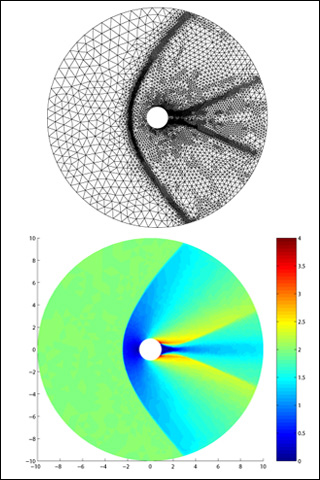
An adaptive grid (top) used to compute the supersonic flow around a cylinder (Mach number = 2). The methods taught in this class form the foundations for computational fluid dynamic analyses such as this. (Image courtesy of Prof. David Darmofal. Used with permission.)
Instructor(s)
Prof. Karen Willcox
Prof. Qiqi Wang
MIT Course Number
16.90
As Taught In
Spring 2014
Level
Undergraduate
Course Description
Course Features
- Selected video lectures
- Captions/transcript
- Interactive assessments
- Lecture notes
- Projects and examples
- Assignments: problem sets (no solutions)
- Exams (no solutions)
Educator Features
Course Description
This course provides an introduction to numerical methods and computational techniques arising in aerospace engineering. Applications are drawn from aerospace structures, aerodynamics, dynamics and control, and aerospace systems. Techniques covered include numerical integration of systems of ordinary differential equations; numerical discretization of partial differential equations; and probabilistic methods for quantifying the impact of variability. Specific emphasis is given to finite volume methods in fluid mechanics, and finite element methods in structural mechanics.
Acknowledgement: Prof. David Darmofal taught this course in prior years, and created some of the materials found in this OCW site.
Other Versions
Other OCW Versions
Archived versions: ![]()


